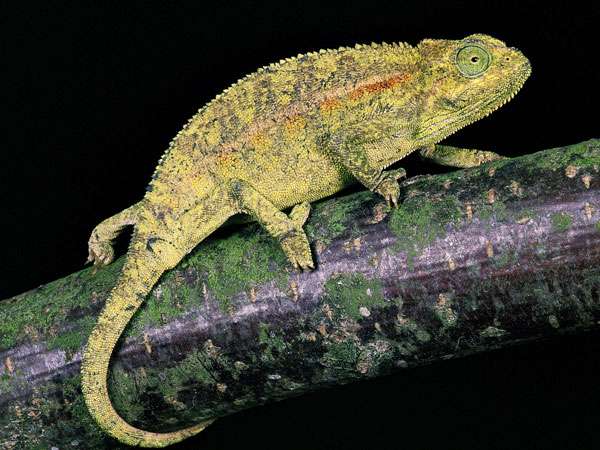
Description:
Scientific name: Trioceros ellioti
Life span: 10 years- up to 20 years
Trioceros ellioti is a species of lizard in the Chamaeleonidae family. It is often referred to as Elliot’s chameleon, Elliot’s groove-throated chameleon, and the montane side-striped chameleon. The hues of Elliott’s Chameleons vary. The palette includes green, gray, brown, and orange. Another aspect that distinguishes Ellioti’s Chameleons living in various regions from one another is the variety in appearance. There are numerous differences in physical characteristics, particularly the hue, even within a single location.
Native Region/Habitat
Burundi, the Democratic Republic of the Congo, Kenya, South Sudan, Rwanda, Tanzania, and Uganda are all home to T. ellioti. T. ellioti prefers to live in forests, savannas, shrublands, and grasslands that are between 1,200 and 1,800 meters above sea level (3,900–5,900 ft). In disturbed regions like gardens, plantations, and open fields, it has also been discovered.

Behavior:
This chameleon is not as tense as some of its larger cousins, yet no chameleon should be treated as a pet to be held and played with. Although there have been accounts of abrupt violent reactions in chameleon-to-chameleon interaction, they typically are not aggressive towards one another.
Care As a pet/In captivity:
Cage Size:
In captivity, Elliot’s Chameleons are housed in cages. They require little movement because they are little. They consequently require little cages as well. A single specimen requires a cage that is at least 16x16x20 inches in size. This cage size is appropriate for seasoned breeders and keepers who have the knowledge necessary to create favorable cage conditions in small areas. The second choice is the spacious 18x18x36-inch cage, which is made for pet owners who maintain chameleons for entertainment purposes.
Humidity:
Elliot’s Chameleons thrive in high humidity at night, but they do well in low humidity during the day. For example, these pet reptiles prefer overnight humidity levels between 75% and 100%. It is advised to reduce the humidity by 30% to 50% during the day so that chameleons can easily participate in a cycle of natural humidity.
Temperature:
The most comfortable ambient daytime temperatures can be in the low to mid-seventies Fahrenheit, while the most comfortable ambient nighttime temperatures can be in the sixties or fifties Fahrenheit. Ellioti’s Chameleons won’t have restful sleep at higher nighttime ambient temperatures.
Elliot’s Chameleons can get their desired basking temperature from basking bulbs while housed in captivity. These domesticated reptiles can be kept warm in the morning by placing halogen or incandescent bulbs on a basking branch.
Although determining the precise perfect temperature for these pet reptiles isn’t a concern, the most ideal basking temperature in this situation should be in the vicinity of 88 Fahrenheit. The chameleons can gain the temperature they require in the morning with just a warm, mild heat.
Food:
The best approach to provide Elliot’s Chameleons the necessary nutrition is through a diversified diet. In order to avoid hunger pangs, the diet meets their nutritional needs. In this way, silkworms, well-fed worms, and roach nymphs are all good stable feeders for your Elliot chameleon.
The food of Ellioti’S Chameleons also includes farm-raised flies, praying mantises, superworms, hornworms, and stick insects. Several fruits and leafy green vegetables are among the other diet’s components.
Table





